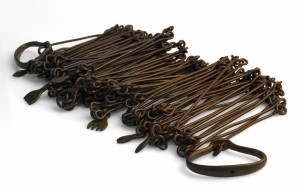 Despite our 'modernity,' we continue to use the ancient Babylonian sexaguesimal (base 60) counting system to measure angles and time. Understanding this system is therefore important. It is even more important because it helps us better understand our modern decimal system of numbers.
Despite our 'modernity,' we continue to use the ancient Babylonian sexaguesimal (base 60) counting system to measure angles and time. Understanding this system is therefore important. It is even more important because it helps us better understand our modern decimal system of numbers.
In this video I demonstrate how to add using Babylonian (cuneiform) numerals. I then show how to add our modern measures of angles and time using the same system (on a white board).
You will also learn a little about John Wallis, a contemporary of Sir Isaac Newton, who generalised the symbols that we use to keep track of what each column represents (i.e. degrees, minutes and seconds)!
John Wallis was not the first, however. For many years, Arabic and Persian scholars had been making astronomical calculations using sexaguesimal notation. In order to understand how they did this we need to understand place value in our current decimal system. When we write our decimals numbers, we are really writing a list of fractions with a decimal point as a marker. Hence 6.438 means 6 + 4/10 + 3/100 + 8/1000.
In an almost identical way, Arabic and Persian scholars (such as al-Kashi, c.1380-1429) wrote their sexaguesimal fractions in columns. For them the number 3 6 14 43 29 would mean 3 + 6/60 + 14/3600 + 43/216000 + 29/12960000 (where 60×60 = 3600, 60×60×60 = 216000 and 60×60×60×60 = 12960000). It is astounding that the Babylonians coped so well with this system!
In order for them to keep track of which number was in which column, they used to be written in tables with labels written at the head of each column. By the time this system was being translated into Latin for Europeans to read, the sexaguesimal parts were labelled primae minutiae, secundae minutiae, tertiae minutiae, etc. and these Latin terms meant (quite literally), first little bits, second little bits, third little bits, etc. These subdivisions were denoted by writing Roman numerals as superscripts. I am not quite sure how it happened, but the second and third and fourth parts were called just that ... seconds, thirds and fourths. The primes, however, took their name from the other term in primae minutiae, and came to be known as minutes (from minutiae). Hence, now that we have dispensed with thirds and fourths, and so on, we now speak of sexaguesimal fractions in terms of minutes and seconds (rather than primes and seconds)! You will recognise that we still divide our hours (time) and degrees (angles) in this way.
John Wallis and other European scholars adopted this same notation (from the Arabic and Persian scholars). You can see an example here, from page 53 of Wallis' famous 1657 text, Mathesis Universalis:
 You can see that he used the older Roman notation for the number four ... just four strokes (IIII) instead of IV. The same notation was used to the left to denote the degrees as well.
You can see that he used the older Roman notation for the number four ... just four strokes (IIII) instead of IV. The same notation was used to the left to denote the degrees as well.










